Gigabyte's i-RAM: Affordable Solid State Storage
by Anand Lal Shimpi on July 25, 2005 3:50 PM EST- Posted in
- Storage
Using the i-RAM
To begin our testing, we loaded up the i-RAM with four 1GB DDR400 sticks. We didn't have any large DDR200 modules, so unfortunately we had to go with more modern DDR400. Using DDR500, DDR400 or DDR200 doesn't change performance at all, since the Xilinx controller runs them all at the same frequency.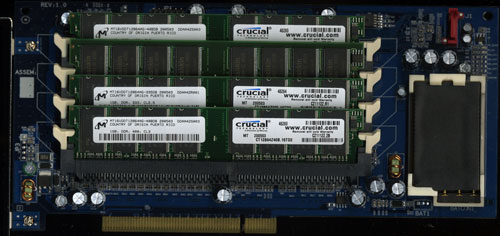
Powering the system on revealed the installation was a success; the BIOS reported the presence of the i-RAM as a regular storage device connected to our SATA controller:
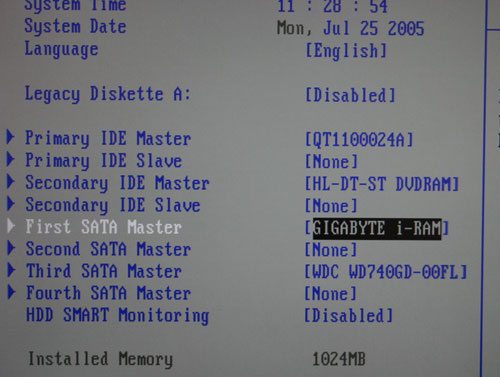
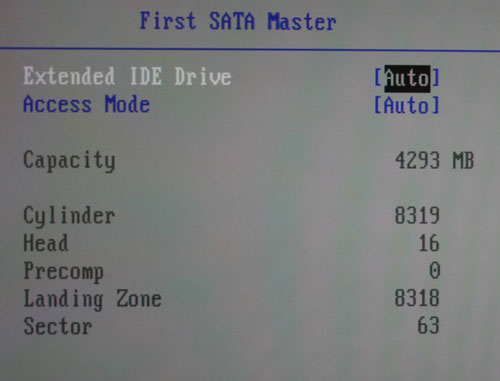
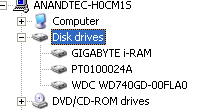
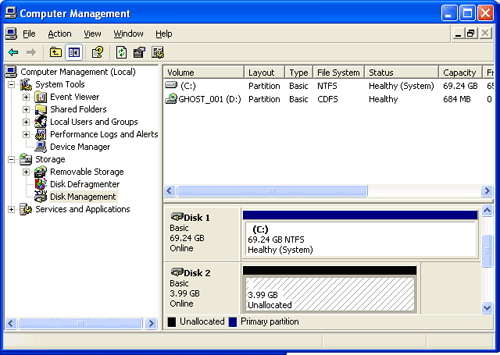
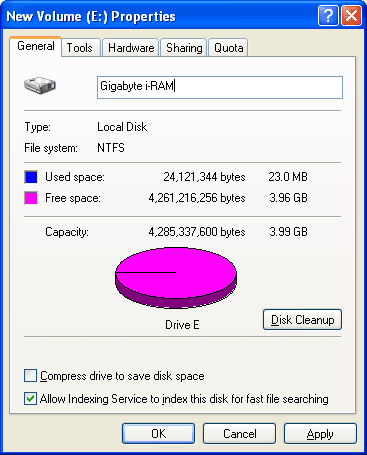
Also, all disk accesses are instantaneous; formatting the thing takes no time at all, and you can even "defragment" it (although, you get no benefit from doing so).
With the setup done, it was time to evaluate the i-RAM as more than just a novelty silent hard drive. Armed with our 4GB partition, we started testing...
The Test
We ran all of our tests on the following testbed unless otherwise noted:ASUS A8N SLI Deluxe nForce4 SLI Motherboard
AMD Athlon 64 FX-57 Processor
1 GB OCZ 2:2:2:7 DDR400 RAM
Seagate 7200.7 120 GB Hard Drive (boot drive)
Western Digital Raptor W740GD (test drive)
Gigabyte i-RAM w/ 4x1GB DDR400 modules (test drive)
We used the latest nForce 6.53 and ForceWare 77.72 drivers for our test bed, and paired it with the recently released GeForce 7800 GTX.










133 Comments
View All Comments
mattsaccount - Monday, July 25, 2005 - link
This thing would still be useful as a pagefile in some circumstances--if all your memory slots were full and/or you had extra memory lying around. This is what I had been planning to do with it (currently have 4x512mb, plus a couple other smaller capacity DDR sticks which would be nice to use b/c for photoshop stuff). But the price is too high. I'll wait till it drops.Son of a N00b - Monday, July 25, 2005 - link
I would love to get two of them and run them in RAID-5 possibly...that way you also have a back up...Gatak - Monday, July 25, 2005 - link
You'd need minimum 3 cards/disks for RAID-5.However, using this card as a journaling device for a normal filesystem, like ReiserFS or Reiser4 might be very beneficial. Wouldn't require much RAM either.
ukDave - Monday, July 25, 2005 - link
Extra things that could have been covered were:Would there be a difference with other SATA cards, such as 3Ware etc - i.e. would CPU usage make a difference perhaps?
Why not use SATA-IO (SATA-2) instead of the older and slower SATA (re: Gigabyte)?
But otherwise a very informative article, thanks Anand.
ss284 - Monday, July 25, 2005 - link
It would be best to wait for the second version of the card, which will hopefully have a cheaper IC as well as sata II support. Theres no doubt that the ram can do 3.0gb/s.Imagine what 2 of these in raid 0 would be like.
-Steve
SDA - Monday, July 25, 2005 - link
- File copy performance is mostly a moot point, because copying files from disk to disk will go as fast as the slower of the two can, and other applications that typically require disk performance (unarchiving et al) will only see a minimal performance increase due to bottlenecks in other parts of the system (which becomes even less valuable when you consider that you won't be doing a whole lot of unarchiving to a disk that small).- Gaming benefit would be okay if it you could fit more than about one modern game on it.
- Using it as a pagefile is, as Anand noted, pointless.
- It does improve boot times, but it's not a huge difference, how many of us shut down often enough to actually be bothered by a few seconds in boot?
- It does improve app loading times slightly, but if you're opening and closing apps that take a lot to open and close, it's probably because you don't have enough system memory, so buy more memory instead.
So basically: whoopee.
DerekWilson - Wednesday, July 27, 2005 - link
I'm just gonna pick at a single point ... you could install one game to the i-ram at a time and then archive them on another drive.You get fast zip times on i-ram and a single file transfer to a magnetic disk is faster than multiple small files (moving the the archive won't take long). Just unzip the game you want to play to i-ram ...
but then ... that kinda defeats the purpose doesn't it ...
I could see this being fun to play with, but I have to agree with Anand -- it needs higher capacity before it is really useful.
Plus, I'd like to see SATA-II :-)
miketheidiot - Monday, July 25, 2005 - link
I don't really see anyone using this, its costs way too much for too little storage and too little performance benefit, not to mention the risk of data loss. I'll give it a look again when they get some higher bandwidth flash or something like that. this i can pass on for now.Sea Shadow - Monday, July 25, 2005 - link
I dunno, I could see the extreme enthusiasts getting these. I mean after all, if they have the money to buy a system with SLI 7800 GTX and FX 57 this would be pocket change.BoberFett - Monday, July 25, 2005 - link
I'd imagine that in some areas the CPU is still the bottleneck and for others the 150MB/sec limit of SATA may be.